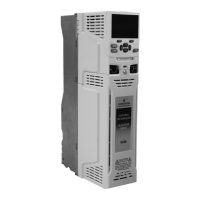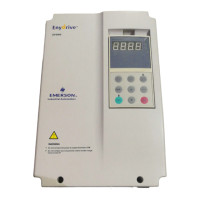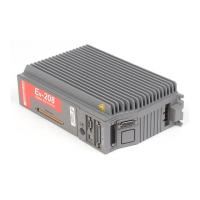Safety
information
Product
information
Mechanical
installation
Electrical
installation
Getting
started
User Menu A Commissioning
Advanced
Parameters
Diagnostics Optimization CT MODBUS RTU Technical Data
E300 Design Guide 251
Issue Number: 1
Braking IGBT Lower Threshold (D19) defines the lowest level of DC Bus Voltage (J65) where the braking IGBT will become active and Braking IGBT
Upper Threshold (D20) defines the level of DC Bus Voltage (J65) where the braking IGBT will be on continuously. When the braking IGBT is turned
on, it will remain on for at least 1 ms. The braking IGBT on-time is defined by the thresholds and the DC Bus Voltage (J65) as given in the table below
where L = Braking IGBT Lower Threshold (D19) and U = Braking IGBT Upper Threshold (D20).
Braking IGBT Lower Threshold (D19) defines the lowest level of D.C. Bus Voltage (J65) where the braking IGBT will become active and Braking
IGBT Upper Threshold (D20) defines the level of DC Bus Voltage (J65) where the braking IGBT will be on continuously. When the braking IGBT is
turned on, it will remain on for at least 1 ms. The braking IGBT on-time is defined by the thresholds and the DC Bus Voltage (J65) as given in the table
below where L = Braking IGBT Lower Threshold (D19) and U = Braking IGBT Upper Threshold (D20).
As the DC Bus Voltage (J65) rises above the lower threshold, the braking IGBT is active with an on/off ratio of 1/100. As the voltage rises further, the
on/off ratio increases until at the upper threshold the braking IGBT is on continuously. The upper and lower voltage threshold can be set up so that
braking resistors in drives with parallel connected D.C. links will share the braking load.
If Braking IGBT Lower Threshold (D19) ≥ Braking IGBT Upper Threshold (D20) then the braking IGBT is off when DC Bus Voltage (J65) < Braking
IGBT Upper Threshold (D20) and on if DC Bus
Voltage (J6
5) ≥ Braking IGBT Upper Threshold (D20). This method of control is the same as that used
in Unidrive SP and the default values for the braking thresholds are equal to the braking thresholds in Unidrive SP.
Unless sharing between braking resistors is required, the braking thresholds do not normally need to be adjusted. Care should be taken when
reducing the thresholds, because if either threshold is below the maximum value of the peak rectified supply voltage the braking resistor could take
power from the supply.
The list below gives conditions that will disable the braking IGBT:
1. Braking IGBT Upper Threshold (D20) = 0, or Low Voltage Braking IGBT Threshold Select (D22) = 1 and Low Voltage Braking IGBT
Threshold (D21) = 0.
2. The drive is in the under-voltage state.
3. A priority 1, 2 or 3 trip is active (see Trip 0 (L29)).
4. One of the following trips is active or would be active if another trip is not already active: OI Brake, PSU, Th Brake Res or OHt Inverter.
5. Percentage Of Drive Thermal Trip Level (J79) = 100%. This is an indication that some part of the drive is too hot and is used to indicate if an
internally fitted braking resistor is too hot.
6. Brake R Too Hot is active or the system has been set up to disable the braking IGBT based on the braking resistor temperature and the
resistor is too hot (i.e. bit 2 of Action On Trip Detection (H45) is set).
See Braking IGBT Lower Threshold (D19).
Voltage Default Value
200 V 390
400 V 780
575 V 930
690 V 1120
D.C. link voltage level On-time
DC Bus Voltage (J65)0%
L ≥ DC Bus Voltage (J65) (J65) [(DC Bus Voltage (J65) - L) / (U - L)] x 100%
DC Bus Voltage (J65) ≥ U 100 %
D20 Braking IGBT Upper Threshold
Mode Open Loop, RFC-A, RFC-S
Minimum -VM_DC_VOLTAGE_SET Maximum VM_DC_VOLTAGE_SET
Default See exceptions below Units V
Type 16 Bit User Save Update Rate 4 ms read
Display Format Standard Decimal Places 0
Coding RW, VM
Voltage Default Value
200 V 390
400 V 780
575 V 930
690 V 1120

